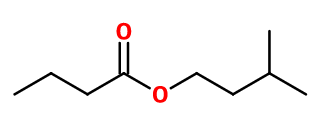Isoamyl Butyrate
Naturelle - Synthétique
Fruity > Yellow Fruits > Green > White Flowers > Butyric

Crédits photo: ScenTree SAS
Other names :
Isoamyl Butanoate ; 3-methylbutyl Butanoate ; Butyric acid 3-methylbutyl ester ; Butyric acid isoamyl ester ; Isopentyl butanoate ; Isopentyl butyrate
Volatility :
Head
Uses in perfumery :
Isoamyl Butyrate is used in all types of perfumes, for fruity-red, yellow and exotic notes. Boosts head notes and provides power and diffusivity.
Natural availability :
Isoamyl Butyrate is present in many fruits in particular, and can be extracted from mastic.
Year of discovery :
Data not available.
Other comments :
Data not available.
Price Range :
€€
Stability :
May form butyric acid through time.

Crédits photo: ScenTree SAS
- Molecular formula :
- C9H16O2
- Molecular Weight :
- 158,27 g/mol
- Density :
- 0,862
- Flash Point :
- 58°C
- Fusion Point :
- Donnée indisponible.
- Appearance :
- Colorless liquid
- Log P :
- 3,3
- Boiling Point :
- 179°C
- Detection Threshold :
- Donnée indisponible.
Synthesis route :
Isoamyl Butyrate is synthesized by an esterification reaction between butyric acid and isoamyl alcohol, or 3-Methylbutanol, using an acid catalyst.
Synthesis precursor :
Isoamyl Butyrate is not a precursor to the synthesis of another compound of olfactory interest.
Isomerism :
Allyl Caproate and gamma-Nonalactone are constitutional isomers of Isoamyl Butyrate. Allyl Caproate also has a fruity and butyric note, but gamma-Nonalactone has a very different peach and coconut smell.
- EINECS number :
- 203-380-8
- FEMA number :
- 2060
- JECFA number :
- 45
- FLAVIS number :
- 09.055
- Allergens :
- This ingredient does not contain any allergen.
- IFRA :
- This ingredient is not restricted
To learn more about IFRA's standards : https://ifrafragrance.org/safe-use/library
ScenTree is solely responsible for the information provided here.

